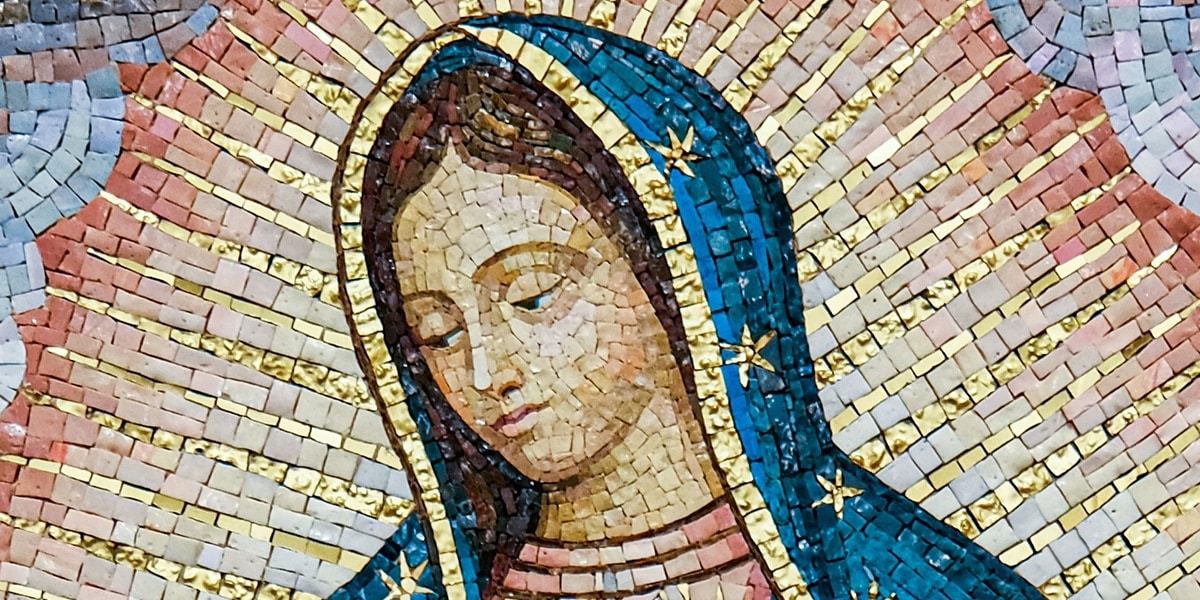Pope Paul VI wrote succinctly: “Mary is held up as an example to the faithful for the way in which in her own particular life she fully and responsibly accepted the word of God and did it….She is worthy of imitation because she was the first and most perfect of Christ’s disciples.”
“I am the Lord’s servant. May it be to me as you have said” (Luke 1:38).
She may be the most famous woman who ever lived, and yet there is surprisingly little in the New Testament about her. Mary is featured only in a few Gospel scenes and the first chapter of Acts. Nevertheless, these Marian passages, arranged in a plausible chronological order, illustrate how quickly devotion for the Virgin Mary developed over the centuries.
Mary in Mark
Among the four Gospel accounts of Jesus’ ministry, Mark’s is generally considered the oldest. In it Mary appears only once (3:21,31-35) and is referred to once more (6:1-6). The basic scene involves a transition in Jesus’ life: He is moving out of the Nazareth family circle into an active career of teaching and healing centered at Peter’s house in Capernaum.
He is attracting such attention that he does not even get time to eat (3:20). His worried family, thinking his behavior strange (“he is beside himself”), sets out to bring him back home. Mark fills in the time required by their journey down to Capernaum by telling how Jesus dealt with scribes from Jerusalem who also fail to understand him (“he is possessed by Beelzebul” [3:22-30]).
Having answered this second misunderstanding immediately, Jesus answers the first only when the family arrives at the lakeside house (3:31-35). Since he is inside surrounded by a crowd, the word has to be passed in: “Your mother and your brothers are outside asking for you.” Jesus’ response (“Who are my mother and my brothers?”) raises the issue of who really constitute his family now that the Kingdom of God is being proclaimed. As his natural family stands outside, Jesus looks at those inside and proclaims, “Here are my mother and my brothers. Whoever does the will of God is brother and sister and mother to me.”
This scene, in which Jesus praises a family of disciples that is obedient to God at the expense of a natural family that does not understand him, would not incline readers to develop devotion to Mary. Yet it is regarded by many non-Catholics as the basic Marian text, perhaps in reaction to Catholic elevation of Mary.
The dourness of the Marcan outlook is not alleviated by 6:1-6. The locals at Nazareth are astounded at Jesus’ religious prominence: “Where did this fellow get all this wisdom? Isn’t he a carpenter? Isn’t he the son of Mary, and the brother of James and Joses and Judas and Simon? Aren’t his sisters here with us?” In response to the townspeople who have taken offense at the local carpenter-turned-preacher, Jesus compares himself to a prophet who is not honored in his own region, among his own relatives and in his own house. Another discomforting passage for a positive appreciation of Mary!
Mary in Matthew
A significant change in outlook comes about because Matthew has a story of Jesus’ conception and birth that was lacking in Mark. Joseph is married to Mary but has not yet taken her to live with him. A shocking report reaches him that Mary is pregnant, but before he can take action to dissolve the marriage by divorcing her, an angel appears in a dream (Matthew 1:18-25). The angel reveals to Joseph that Mary’s conception is from the Holy Spirit (not from a male); her child to be named Jesus will save his people from their sins and embody God’s presence with us (Emmanuel).
Although Matthew is silent about Mary’s reaction to this intervention by God, the conception creates a context for Matthew’s treatment of Mary in the ministry. Surely this uniquely privileged mother would have understood when Jesus began his ministry of proclaiming God’s kingdom. Accordingly when Matthew draws on Mark 3, he completely omits 3:20-21, in which the family thinks Jesus is beside himself and sets out to bring him home.
When Jesus returns to Nazareth (Matthew 13:54-58), he acknowledges that he is not honored in his own region and in his own house, but makes no mention of being dishonored by his own family. Nevertheless, Matthew 12:46-50 reports virtually unaltered the family-choice scene recounted in Mark 3:31-35: Jesus still gives preference to disciples related to him by doing God’s will.
Mary in Luke/Acts
Contrasted to the portrayal of Mary in Mark and Matthew, which ranges from dark to neutral, this two-volume work paints her in much warmer colors. While the mother of Jesus had only a restricted role in the Matthean infancy narrative, the virgin of Nazareth (Luke 1:26-27) is the principal figure in the Lucan infancy narrative.
Here too (although the situation is indicated only indirectly) she and Joseph have been married but have not yet lived together. In an appearance to Mary (1:30-33) the angel Gabriel, quoting freely from 2 Samuel 7:12-16, announces that she is going to be the mother of the Davidic Messiah. When Mary asks how this is to be since she is a virgin, the angel quotes what Luke’s readers would recognize as the language of Christian preaching: “The holy Spirit will come upon you; the power of the Most High will overshadow you; and so the child will be called holy, the Son of God” (1:34-35).
Paul uses similar imagery (Holy Spirit, power, divine sonship) in Romans 1:3-4 to phrase the gospel of Jesus as Son of David and Son of God. In the same way here, Luke is presenting Mary as the first one to hear the gospel. She responds, “Let it be done unto me according to your word.” Thus she fulfills perfectly the requirement we saw in Mark for the family of disciples: “Whoever does the will of God is…mother to me.”
Next the Lucan Mary acts out her discipleship in two ways. First, she hastens to go to her relative Elizabeth to share the good news. By way of full response to the gospel, Christian disciples do not simply receive and hold on to what God has revealed; they communicate it to others. Mary’s arrival causes Elizabeth, under the influence of John the Baptist in her womb, to prophesy in praise of Mary.
Like the heroic women deliverers of Israel, Jael and Judith (Judges 5:24; Judith 13:18), Mary is titled “blessed among women.” Moses had said that, if Israel heeded the voice of God, the wombs of the Israelite women would be blessed with fruitfulness (Deuteronomy 28:1,4). Elizabeth, recognizing that Mary’s womb is uniquely fruitful, blesses her as the mother of the Lord (Luke 1:41-44).
But Mary’s heeding the word of God in the Annunciation had another dimension beyond that envisioned by Moses—a gospel dimension that Elizabeth recognizes when in 1:45 she blesses Mary a second time for having believed (and thus having met the criterion of discipleship). If all future generations will call Mary blessed (1:48), they will do so in fidelity to Elizabeth’s prophetic recognition of her roles as mother of the Lord and true Christian disciple.
Second, Mary develops discipleship to the fullest by blessing God in the Magnificat (1:46-55). In that hymn Mary interprets the good news she has brought to Elizabeth. The angel told Mary who Jesus is, namely, Messiah and Son of God; but Mary translates this identity in terms of what his coming means.
On the one hand, God’s gift of Jesus shows strength to Israel, exalts the lowly and fills the hungry; on the other hand, it scatters the proud, puts down the mighty and sends the rich away empty. Mary is anticipating the gospel of her son who, though proclaimed by God as Divine Son (3:22), proclaimed himself in terms of blessings for the poor, the hungry and the sorrowful, and woes for the rich, the satisfied and the revelers. More than any other biblical passage, the Magnificat has made Mary an emblem of hope and a sign of God’s care for the oppressed and downtrodden throughout the world.
In the scenes immediately following the birth of Jesus, Matthew (2:11,14, 21) mentions Mary only as a passive object of care. For Luke, next to God she is the major actor. While others are amazed at the glorious news of the birth of the Messiah and Lord, Mary treasures away all these things carefully, interpreting them in her heart (Luke 2:19). This echoes the language of Genesis 37:11, Daniel 4:28 (Greek) and 7:28 in which a visionary reflects on a mysterious revelation, only part of which he has fully understood.
Despite what has been revealed to her, the way that Jesus’ career will work out will be a trial and involve decision even for Mary, as Simeon prophesies figuratively in Luke 2:34-35 in terms of a sword passing though her soul. The last scene of the Lucan infancy narrative, when Jesus reaches age 12, illustrates her difficulty. She and Joseph cannot understand the way he has behaved in the Temple and his response that he must be about his Father’s business (2:49-50). The challenge to accept God’s unfathomable will in faith is ongoing in the life of the disciple.
That Mary met the ongoing challenge is shown in the Lucan form of the basic ministry scene we saw first in Mark. No longer are the mothers and brothers who come looking for Jesus contrasted with the family created by discipleship. Rather, they are the best examples of those who hear the word of God and do it (Luke 8:19-21), the group that are like the parabolic seed in the good soil mentioned a few verses before (8:15), namely, those “who, hearing the word, hold it fast.” Indeed, the mothers and the brothers endure into the beginnings of the Church, for they are counted in Acts 1:13-14, alongside the Twelve and the women, among the believers awaiting the Pentecostal coming of the Spirit.
Mary in John
Although this Gospel has no infancy narrative, it has two ministry scenes involving Mary. In content they differ from the accounts in the first three Gospels, but the basic theological issues are the same.
At Cana, a scene in which Jesus moves from family life to public ministry, his mother and brothers are attending a wedding (John 2:1-12). The mother’s implicit request— “They have no wine”—exerts a family claim on Jesus, similar to the mother and brothers coming to look for Jesus in the basic Marcan scene. The rejection of that claim in terms of “My hour has not yet come” is similar to the Lucan Jesus’ response to his mother’s complaint about his behavior at age 12, “Did you not know that I must be about my Father’s business?”
In relation to earthly family both answers give priority to the role assigned to Jesus by the heavenly Father who sent him. Yet the mother of Jesus in John persists with, “Do whatever he tells you,” similar to Mary’s response to the angel in Luke 1:38, “Let it be done to me according to your word.“
The second Johannine scene, which takes place at the foot of the cross (John 19:25-27), confirms that Mary’s final reaction at Cana reflected the obedience characteristic of disciples. The hour has come (13:1); Jesus is finishing the work the Father has given him to do (19:28-30); gathered around him is a group of followers who have remained loyal to the last. Chief among them are two figures whom John has mentioned but whose personal names he never supplies, namely, the mother of Jesus and the disciple whom he loves.
By making the former the mother of that disciple, and the latter his own mother’s son, Jesus is establishing a family of disciples. This is John’s form of dealing with the “Who are my mother and my brothers?” issue. If in Mark and Matthew there was a contrast between two families, one by nature and the other by discipleship, in John (as in Luke) the natural mother is brought into the family of discipleship in a preeminent way, for she now is the mother of the most perfect disciple who becomes Jesus’ brother.
Later theology will recognize that God accorded Mary many privileges, but all of them are derivative from those already found in the sparse New Testament references. She was the mother of God’s Son, the Messiah; she met the requirements of discipleship in an outstanding way. Pope Paul VI wrote: “Mary is held up as an example to the faithful for the way in which in her own particular life she fully and responsibly accepted the word of God and did it….She is worthy of imitation because she was the first and most perfect of Christ’s disciples.”








